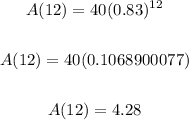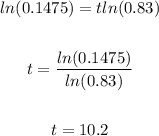Given the function:

Where A(t) shows the amount of drug in a body after t hours.
Let's solve for the following:
• (a). Initial dosage:
Apply the exponential functions:

Where:
a is the initial value
b is the change factor.
Thus, we have the following:
a = 40
b = 0.83
Therefore, the initial dose is 40 mg.
• (b). What percent leaves the body each hour?
Apply the function:

Where:
r is the decay rate.
Thus, we have:
b = 1 - r
r = 1 - b
r = 1 - 0.83
r = 0.17
The percent that leaves the body each hour will be:
0.17 x 100 = 17%
Therefore, 17 percent of the drug leaves the body each hour.
• (c). What amount of drug is left after 12 hours?
Substitute 12 for t and solve for A(12):

The amount left after 12 hours is 4.28 mg.
• (d). The first whole number of hours at which there is less than 6 mg left.
Plug in 5.9 for A(t) and solve for t.

Divide both sides by 40:

Take the natural logarithm of both sides:

Therefore, the first whole number of hours where there is less than 6 mg left is 10 hours.
ANSWER:
• (a) 40 mg
,
• (b) 17%
,
• (c). 4.28 mg
,
• (d). 10 hours